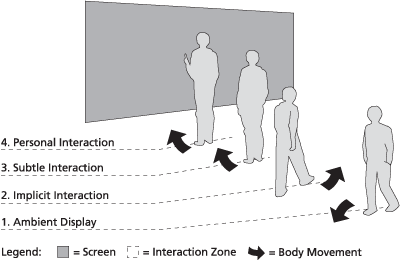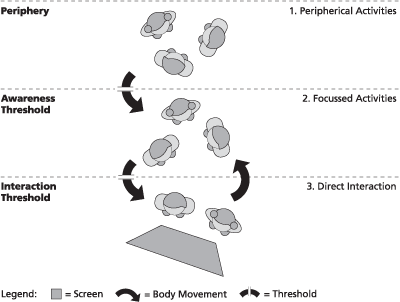I subscribe to Martijn de Waal's blog, The Mobile City: Locative & Mobile Media/Urban Culture/Identity, partly because of my interest in ubiquitous/pervasive computing (specifically how technology can support interaction and collaboration between people across screens of all sizes in public spaces), and partly because I am interested in looking at the ways different disciplines adopt, adapt, and transform emerging interactive technologies.
If you are interested, take a look at my recent post about Martijn de Waal and topics related to locative/mobile media on The World Is My Interface blog.
Focused on interactive multimedia and emerging technologies to enhance the lives of people as they collaborate, create, learn, work, and play.
Showing posts with label urban computing. Show all posts
Showing posts with label urban computing. Show all posts
Oct 31, 2009
Oct 5, 2009
Adam Greenfield's Encounter with Fashionable Urban Screens
Curious? I posted about it on The World Is My Interface blog, along with links to Adam's blog post and related information:
Adam Greenfield's Encounter with Fashionable Urban Screens: "jnd: An emergent vocabulary of form for urban screens"
Posted by
Lynn Marentette
Aug 7, 2009
Foursquare: Interactive Local + Social Media Coming to a City Near You.
Foursquare is a locative-mobile system/game/social media game/activity that is starting to grow in popularity in a number of urban settings, such as NYC. It hasn't arrived in Charlotte, so I can only share what I've gleaned about it from the Foursquare website and a few reviews:
"We're all about helping you find new ways to explore the city. We'll help you meet up with your friends and let you earn points and unlock badges for discovering new places, doing new things and meeting new people."
"It's foursquare! Think: 50% friend-finder, 30% social cityguide, 20% nightlife game. We wanted to build something that not only helps you keep up with your friends, but exposes you to new things in and challenges you to explore cities in different ways. There's a lot of experimenting here, so bear with us as we try to figure it all out (and thanks!)"
"We have an iPhone app, a mobile-web site (Blackberry! Treo!) and an SMS shortcode (50500) that you can text check-ins to. For more info, look here." (For more information, visit the Foursquare NYC website.)
RELATED:
Foursquare: Check In, Tweet....Money on Beer (Jennifer Van Grove, Mashable, 8/7/2009)
"Foursquare is poised to be a prime player in the location-based social networking space."
Forsquare: Why it May Be the Next Twitter (Jennifer Van Grove, Mashable, 7/25/2009)
"The Game: To those of you not playing, it may sound like a joke, but don’t knock it till you try it. You earn points for every check-in — unless of course you check-in at the same locale all the time. You’re rewarded with more points for being adventuresome (exploring different parts of the city), for hitting up multiple spots in one night, and eventually for the tips other people try and the to-dos you complete."
Screen-shot from Jennifer Van Grove's Foursquare App:

Building an Army of Hyper-Local, Mobile-Connected Advocates: Or, Why Marketers Should Pay Attention to Foursquare (Allison Mooney, Ad Age Digital, 8/5/09)
"Co-founder Dennis Crowley puts it this way: "I think Foursquare found some kind of sweet spot between the intersection of social utility (Hey, I know where my friends are), sharing/oversharing (I log everywhere I go/everything I do) and gaming/rewards (every check-in gives you a little piece of candy)."
Cities: Amsterdam, Atlanta,Austin, Boston, Chicago, Dallas/Ft. Worth, Denver, Detroit, Houston, Las Vegas, Los Angeles, Miami, Minneapolis/St. Paul, NYC, Philadelphia, Phoenix, Portland, San Diego, San Franscisco, Seattle, Washington D.C.
(Also posted on the Technology Supported Human-World Interaction blog.)
"We're all about helping you find new ways to explore the city. We'll help you meet up with your friends and let you earn points and unlock badges for discovering new places, doing new things and meeting new people."
"It's foursquare! Think: 50% friend-finder, 30% social cityguide, 20% nightlife game. We wanted to build something that not only helps you keep up with your friends, but exposes you to new things in and challenges you to explore cities in different ways. There's a lot of experimenting here, so bear with us as we try to figure it all out (and thanks!)"
"We have an iPhone app, a mobile-web site (Blackberry! Treo!) and an SMS shortcode (50500) that you can text check-ins to. For more info, look here." (For more information, visit the Foursquare NYC website.)
RELATED:
Foursquare: Check In, Tweet....Money on Beer (Jennifer Van Grove, Mashable, 8/7/2009)
"Foursquare is poised to be a prime player in the location-based social networking space."
Forsquare: Why it May Be the Next Twitter (Jennifer Van Grove, Mashable, 7/25/2009)
"The Game: To those of you not playing, it may sound like a joke, but don’t knock it till you try it. You earn points for every check-in — unless of course you check-in at the same locale all the time. You’re rewarded with more points for being adventuresome (exploring different parts of the city), for hitting up multiple spots in one night, and eventually for the tips other people try and the to-dos you complete."
Screen-shot from Jennifer Van Grove's Foursquare App:
Building an Army of Hyper-Local, Mobile-Connected Advocates: Or, Why Marketers Should Pay Attention to Foursquare (Allison Mooney, Ad Age Digital, 8/5/09)
"Co-founder Dennis Crowley puts it this way: "I think Foursquare found some kind of sweet spot between the intersection of social utility (Hey, I know where my friends are), sharing/oversharing (I log everywhere I go/everything I do) and gaming/rewards (every check-in gives you a little piece of candy)."
Foursquare is designed with these game dynamics in mind, and it's the absurd appeal of its reward that makes the service so "sticky.""
Naveen Selvadurai (Foursquare Co-Founder)Cities: Amsterdam, Atlanta,Austin, Boston, Chicago, Dallas/Ft. Worth, Denver, Detroit, Houston, Las Vegas, Los Angeles, Miami, Minneapolis/St. Paul, NYC, Philadelphia, Phoenix, Portland, San Diego, San Franscisco, Seattle, Washington D.C.
(Also posted on the Technology Supported Human-World Interaction blog.)
Posted by
Lynn Marentette
Apr 17, 2009
Interactive Displays in Public Spaces
Daniel Michelis recently completed his Ph.D. dissertation on a topic that is dear to my heart. Information about his research can be found on his Interactive Displays in Public Spaces blog.
(Note: This was cross posted on the Technology-Supported Human World Interaction blog.)
Here are links to a few of his posts:
Interactive Displays: Perception, Awareness, and Interaction
Evaluating Interaction with Display Applications in Public Space
I especially like the diagrams Daniel uses to depict zones of interaction:

(Note: This was cross posted on the Technology-Supported Human World Interaction blog.)
Here are links to a few of his posts:
Interactive Displays: Perception, Awareness, and Interaction
Evaluating Interaction with Display Applications in Public Space
I especially like the diagrams Daniel uses to depict zones of interaction:
Figure 3: Four-phase Model
(Source: Daniel Michelis (2009), according to: Vogel and Balakrishnan, 2004)
(Author: Daniel Michelis, Institute for Media and Communications Management, University of St. Gallen)

Posted by
Lynn Marentette
Subscribe to:
Posts (Atom)

